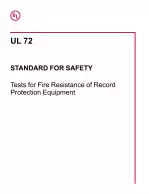UL 72:2020 PDF Download
Standard EN SampleStandard for Tests for Fire Resistance of Record Protection Equipment
Also Known As:
The UL 72:2020 standard outlines the test procedures for evaluating the fire-resistance classification of record protection equipment. This equipment is designed to safeguard various types of records during exposure to different durations of fire.
Record protection equipment encompasses movable devices with different configurations, such as insulated bodies with insulated doors, drawers, or lids, multidrawer devices with individually rated drawer bodies, and similar constructions.
The tests conducted in accordance with this standard aim to assess the performance of record protection equipment during fire exposure. However, the tests do not determine the acceptability of the equipment for use after a fire incident.
The standard includes fire endurance tests and explosion tests for record protection equipment. Additionally, equipment designed for impact resistance undergoes fire and impact tests. The fire endurance test evaluates the ability of the equipment to prevent internal temperatures and relative humidity from exceeding specified limits during the desired classification. The explosion test examines the equipment's capacity to withstand sudden exposure to high temperatures and prevent explosive reactions. The fire and impact test assesses the equipment's ability to protect its contents from heat before and after a 30 ft (9.1 m) fall.
It should be noted that the specified fire exposures in the tests may not fully represent all possible fire conditions. Fire conditions can vary depending on factors such as fire loading, building construction, and device placement within the building.
The three classes of record protection devices (Class 350, Class 150, and Class 125) have interior sample temperature and relative humidity limitations that align with the type of records they are designed to store. Class 350 devices aim to protect paper records, Class 150 devices cater to paper and non-paper records like EDP media and photographic records, while Class 125 devices also safeguard flexible computer disks. However, non-paper records are not utilized as test contents since the standard does not cover the testing of all available non-paper records.
While record protection equipment may incorporate locking mechanisms, the standard does not address the burglary resistance of these mechanisms.
| Edition | 16 |
| Language(s) | English |
| File Size | 368.6 KB |


